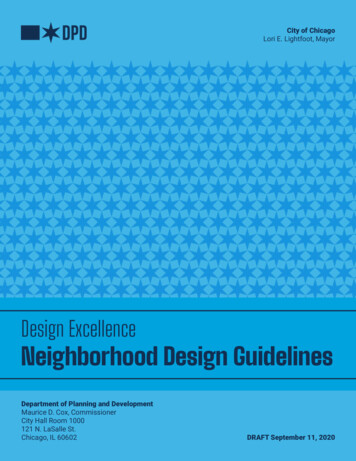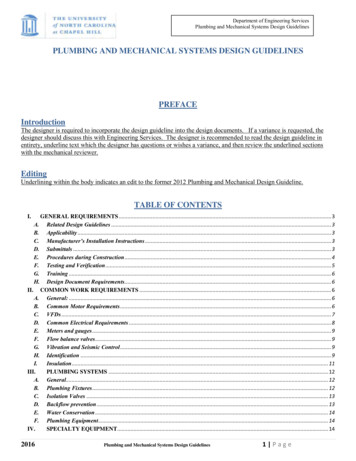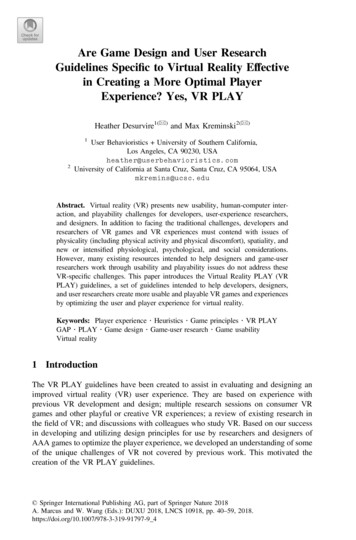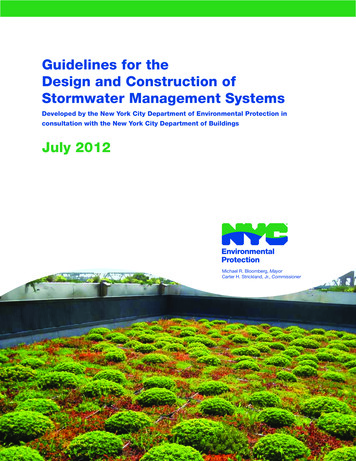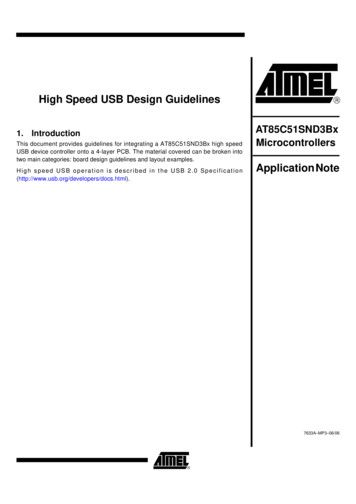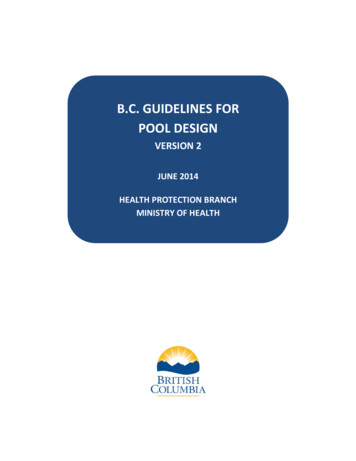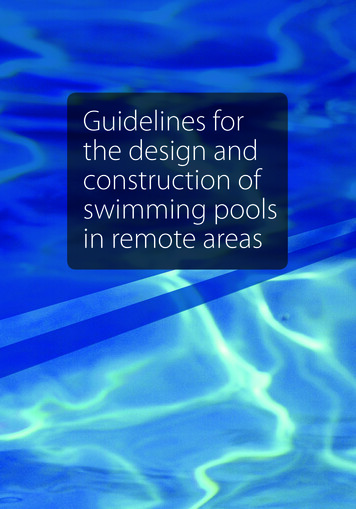
Transcription
Guidelines forthe design andconstruction ofswimming poolsin remote areas
Acknowledgements:The “Guidelines for the design and construction of swimming pools in remote areas” is a resultof collaboration between the Local Government Association of the Northern Territory (theAssociation), the Department of Families, Housing, Community Services and Indigenous Affairsand the Royal Life Saving Society of the Northern Territory.The Local Government Association of the Northern Territory would like to acknowledge thetechnical support of Statewide Pools Pty Ltd, Biotext Pty Ltd and Colemans Printing in theproduction of the Guidelines.Also the Association would like to recognise the input and information received from poolmanagers and operators working in remote communities, their accumulated experience andtheir dedication have been invaluable.CopyrightThese Guidelines are copyright. This work maybe produced in whole or part for research,training, planning , or report purposes subject to the inclusion of reference to and theacknowledge of the source, and provided no commercial usage or sale is made. Apart from anyuse as permitted under the Copyright Act 1968, all other rights are reserved.Guidelines for the design and construction of swimming pools in remote areas.3
1 Introduction1.11.21.31.3.11.3.21.3.31.41.5Using these guidelinesStages for swimming pool procurementDefinitionsRemote communityPublic swimming poolWater play areaUseful termsReferences and further reading2 Stage 1 – 42.4.12.52.6Community involvementSwimming pool committeePreplanning process leadershipBudgetCommunity analysisPopulation and demographicsTown or community planCommunity tenancy arrangementsLocation optionsPower and waterCurrent arrangements for swimmingPotential user groupsAlternative recreation or sporting facilitiesLocal employment and trainingCommunity groups and leadersCultural valuesSources of funding for community projectsOther information sourcesDecision – defer, abandon or proceed?Water play areasUseful termsReferences and further reading3 Stage 2 – ommunity involvementDraft business modelManagement structurePool user estimatesProgramsStaffingMarketing and communicationsLocation selectionConcept designGuidelines for the design and construction of swimming pools in remote 121222222222324252527292930303131333435
.7.33.83.93.10Technical design optionsThe Royal Life Saving Society – Australia’s guidelinesPool sizePool construction materials and methodologiesWater treatment plantFinancial planCapital budgetOperating budgetRisk assessmentIdentifying riskGrading riskTreating riskRecommendationsGlossaryReferences and further reading4 Stage 3 – Design and 84.9The project design briefThe project managerThe steering committeeThe project teamMultiple consultantsDesign and constructThe tender processSpecificationsFinal designProject monitoringUseful termsFurther reading656565666667676869697070715 Stage 4 – Project 73CompletionHandoverDefectsSafety assessmentTrainingInsuranceProject documentationAs-built drawingsOperation and maintenance manualWarrantyAsset registerPlant maintenance registerUseful termsFurther reading7373747474757575767676767777Guidelines for the design and construction of swimming pools in remote areas.5
AppendicesAppendix AAppendix BAppendix CAppendix DAppendix EAppendix FCase studiesSample preplanning report summaryWater play areasSample duty rosterSample operations manual contentsSample asset registerBibliography7999101105107109111TablesTable 1.1Table 3.1Table 3.2Table 3.3Table 3.4Table 3.5Table 3.6Table 3.7Table 3.8Table A.1Table A.2Table A.3Table A.4Table C.1Table D.1Table F.1Summary of the stage objectives for swimming pool procurement12Example daily schedule (school term weekday)32Swimming pool size requirements for different programs38Depth requirements for pool programs39Required turnover times for Northern Territory pools48Comparison of the different forms of chlorination52Operating expenditure forecast57Hypothetical operating scenarios for a remote community swimming pool59Risk assessment chart61Key data for case study 181Key data for case study 286Key data for case study 391Key data for case study 495Advantages and disadvantages of water play areas (WPAs) compared to swimming pools 102Example of a duty roster for a small swimming pool facility105Sample asset register109FiguresFigure 1.1Figure 1.2Figure 3.1Figure 3.2Figure 3.3Figure 3.4Figure 3.5Figure 3.6Figure 3.7Figure 3.8Figure 3.9Figure 3.10Figure 3.116Stages for swimming pool procurementPopulation distribution by size of community (remote), 2006Flowchart for feasibility studySample organisation chartExample concept designSwim benchFully formed pool under constructionFully formed poolDiagram of sprayed pool constructionPneumatically applying concrete on a sprayed poolDiagram of metal frame pool constructionFibreglass panel pool constructionSchematic of a pool water-treatment systemGuidelines for the design and construction of swimming pools in remote areas.13142831363941414243444546
Figure 3.12Figure 3.13Figure 3.14Figure 3.15Figure 3.16Figure 3.17Figure 3.18Figure A.1Figure A.2Figure A.3Figure A.4Figure A.5Figure A.6Figure A.7Figure A.8Figure A.9Figure A.10Figure A.11Figure A.12Figure A.13Figure A.14Figure A.15Figure A.16Figure A.17Figure A.18Figure A.19Figure A.20Figure A.21Figure A.22Figure A.23Figure A.24Figure A.25Schematic of surface water take-off systemsWet deckA filtration systemSchematic of a wastewater treatment systemSolar absorber ‘flow-through’ panelsPhotovoltaic electrical panelsSolar blanketsSite plan of case study 1Swimming pool under constructionSwimming facility under constructionBeach/toddler section ready for surfacingPool filled and site cleaned ready for handoverPool fence dividing beach/toddler section and play/lap sectionsSite plan of case study 2Outdoor lap pool under constructionStructure completed and tiling in progressCompleted outdoor lap poolEntry stairs with safety railCombined outdoor lap pool and toddler pool filtrationSalt-chlorinator cellsToddler pool with shadeSite plan for case study 3Excavation of the outdoor pool beginsCompleted buildings, and starting the outdoor poolFiltration system showing pipework, valves and labellingCompleted pool being cleaned for handoverSite plan for case study 4Completed outdoor lap pool after a dust storm (cleanup needed before fill)Final stages of works and the toddler pool being testedFinal stages of works before handoverPool, showing the perimeter fencing without a dust barrier, being prepared for handoverPlant room showing (left to right): power control box, circulation pumps and 092929393949696979798Acronyms and n Bureau of StatisticsAustralian Capital TerritoryAustralian Standard Geographical ClassificationAustralian StandardsAustralian / New Zealand StandardsCommonwealth Development Employment ProjectDiatomaceous earthDepartment of Housing and WorksGuidelines for the design and construction of swimming pools in remote areas.7
ment of Families, Housing, Community Services & Indigenous AffairsFiltered waterKilolitresKilopascalsLitres per person per dayLearn to swimMinister of HousingSquare metresCubic metresNew South WalesNorthern TerritoryNational Water Quality Management StrategyOccupational Health and SafetyPools in Remote AreasPool water treatment plantQueenslandRemote Aboriginal Swimming Pool ProjectReverse OsmosisRoyal Life Saving SocietySouth AustraliaSwimming pool committeeSoiled waterStandard operating proceduresUltra filtrationTasmaniaUltravioletUnplasticised Polyvinyl chloride, a thermoplastic polymer.Ultraviolet radiationVictoriaGuidelines for the design and construction of swimming pools in remote areas.
Introduction
1IntroductionProcuring a swimming pool facility is a complex and often difficult task, especially in remotecommunities. Many resources and skills are required, and the time needed to properly plan anddeliver a swimming pool is easily underestimated (see Figure 1.1). The Royal Life Saving Society– Australia’s Review of Swimming Pools in Remote Areas of the NT (RLSSA 2011) revealed thatmany communities made errors when approaching the swimming pool procurement process,and the ensuing problems were highlighted. Through extensive consultation with stakeholdersfrom 18 remote communities, as well as local, territory and federal government agencies, thereport investigated the issues and opportunities of 18 swimming pools in remote areas of theNorthern Territory. The pools were mostly in remote Indigenous communities, although somewere in small regional towns. The document concluded that remote area swimming pools area core community service with potential benefits that reach beyond the simple recreationalswimming opportunities for children and interested adults, and that guidelines for the designand construction of swimming pools should be developed as a high priority. These suggestionsformed the basis for these guidelines.Table 1.1 Examples of poorly planned swimming pool facilitiesExample 1In a remote Australian community, there is a swimming facility that includes an empty pool.It sits apart from the main pool and toddler pool, and is rarely used. When the communitywas planning the facility, someone suggested that it would be a good idea to have a smallpool, separate from the other pools, that the community elders could use as a pleasant, coolmeeting point in hot weather. However, it is not known why the pool is not used; perhaps it isbecause the elders do not want to bathe in public, or because the pool has no shade, is quitedeep and has narrow, steep steps without suitable handrails.Example 2A remote community recently opened a 25 metre pool and toddler pool. The community mademany sacrifices and invested substantial resources in this new pool, and the opening ceremonywas a proud and satisfying occasion. Later, there was disappointment when the pool filterswere backwashed and wastewater was found running from the pool’s plant area down a streettoward the community store. No allowance had been made for wastewater disposal.Example 3A newly built pool facility is closed most of the time because of lack of funds for lifeguardsand other operating costs.These guidelines aim to ensure the sustainability of future public swimming pools in remoteareas by providing a best practice framework for the entire process, from planning throughto construction and handover to the community. Councils and communities may use theseguidelines in their decision-making processes.10Guidelines for the design and construction of swimming pools in remote areas.
Two previous publications, the National Indigenous Infrastructure Guide (FaHCSIA 2010) and theNational Indigenous Housing Guide (FaHCSIA 2007), are important readings for communitiesconsidering building a new swimming pool facility, and will complement these guidelines.These three publications focus on appropriate and sustainable infrastructure based on six keyprinciples: access and equity environmental health health and safety appropriateness affordability sustainable livelihoods.These principles are as relevant to community swimming pools as they are to otherinfrastructure. There is ample evidence that, where these principles are followed, the swimmingpool facilities have significant positive impacts on remote communities (NCEPH 1999).Swimming pools are linked to a variety of positive health outcomes including improvementsin general wellbeing, as well as reductions in eye, ear and sinus infections. Swimming poolsin remote communities also provide children with the opportunity to learn valuable andpotentially lifesaving swimming skills, and can allow healthy sport and recreation whenhigh heat and humidity may not be suitable for other activities, such as football, tennis andbasketball.The RLSSA report confirms that there is evidence of community benefit, but also acknowledges that: without a coordinated response to managing swimming pools in remote areas,talk of health, social or economic benefits [is] largely academic, as swimming poolsmust be accessible, functioning and well integrated into community life for any suchbenefits to be realised. (RSSLA 2011)The report implies that, in addition to needing coordinated management of swimming pools,there must be appropriate design and construction processes, and community wellbeing –both local and in the wider sense – is adversely affected by inappropriate or poorly designedand built swimming pools. These guidelines aim to make communities aware of the pathwaysand pitfalls in the swimming pool procurement process.Swimming pool facilities not only involve the actual swimming pools, but also the associatedinfrastructure, such as ablutions, change rooms, first-aid rooms, plant rooms, shade structures,power and sewerage, air-handling systems and car parking. These guidelines concentrate onGuidelines for the design and construction of swimming pools in remote areas.11
the swimming pools themselves, but the National Indigenous Infrastructure Guide (FaHCSIA2010) and National Indigenous Housing Guide (FaHCSIA 2007) are both valuable resources forcommunities to use when procuring these related facilities. The infrastructure guide is relevantto the provision of water, energy, telecommunications and other services that are essentialelements in the design and construction of community swimming
Guidelines for the design and construction of swimming pools in remote areas. 5 3.5 Technical design options 36 3.5.1 The Royal Life Saving Society – Australia’s guidelines 37 3.5.2 Pool size 38 3.5.3 Pool construction materials and methodologies 40 3.5.4 Water treatment plant 45 3.6 Financial plan 55 3.6.1 Capital budget 56 3.6.2 Operating budget 57 3.7 Risk assessment 59 3.7.1 .
